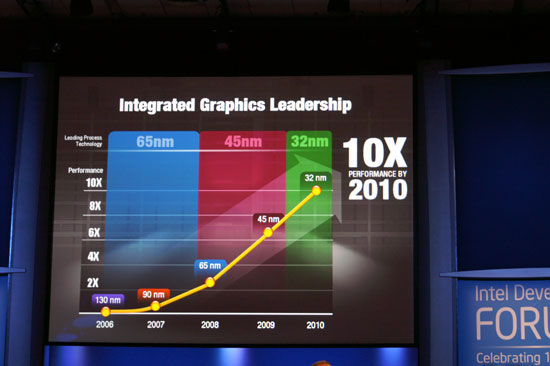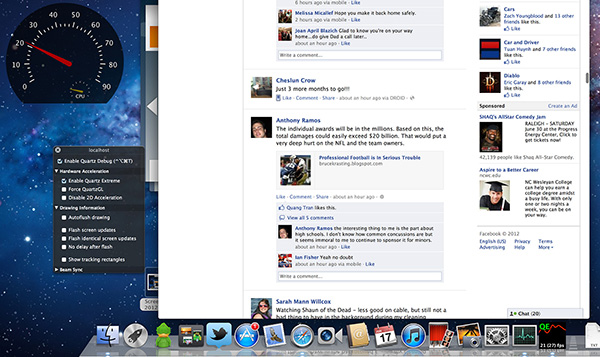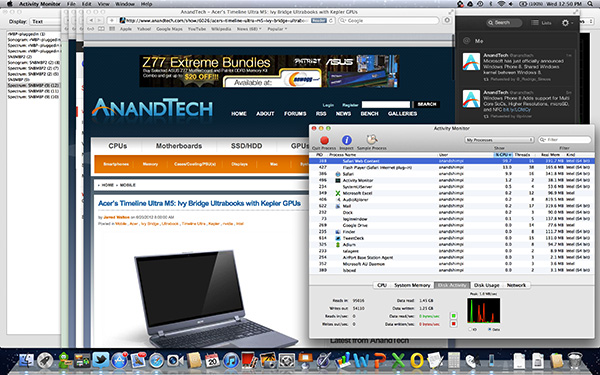The next-gen MacBook Pro with Retina Display Review
by Anand Lal Shimpi on June 23, 2012 4:14 AM EST- Posted in
- Mac
- Apple
- MacBook Pro
- Laptops
- Notebooks
Driving the Retina Display: A Performance Discussion
As I mentioned earlier, there are quality implications of choosing the higher-than-best resolution options in OS X. At 1680 x 1050 and 1920 x 1200 the screen is drawn with 4x the number of pixels, elements are scaled appropriately, and the result is downscaled to 2880 x 1800. The quality impact is negligible however, especially if you actually need the added real estate. As you’d expect, there is also a performance penalty.
At the default setting, either Intel’s HD 4000 or NVIDIA’s GeForce GT 650M already have to render and display far more pixels than either GPU was ever intended to. At the 1680 and 1920 settings however the GPUs are doing more work than even their high-end desktop counterparts are used to. In writing this article it finally dawned on me exactly what has been happening at Intel over the past few years.
Steve Jobs set a path to bringing high resolution displays to all of Apple’s products, likely beginning several years ago. There was a period of time when Apple kept hiring ex-ATI/AMD Graphics CTOs, first Bob Drebin and then Raja Koduri (although less public, Apple also hired chief CPU architects from AMD and ARM among other companies - but that’s another story for another time). You typically hire smart GPU guys if you’re building a GPU, the alternative is to hire them if you need to be able to work with existing GPU vendors to deliver the performance necessary to fulfill your dreams of GPU dominance.
In 2007 Intel promised to deliver a 10x improvement in integrated graphics performance by 2010:

In 2009 Apple hired Drebin and Koduri.
In 2010 Intel announced that the curve had shifted. Instead of 10x by 2010 the number was now 25x. Intel’s ramp was accelerated, and it stopped providing updates on just how aggressive it would be in the future. Paul Otellini’s keynote from IDF 2010 gave us all a hint of what’s to come (emphasis mine):
But there has been a fundamental shift since 2007. Great graphics performance is required, but it isn't sufficient anymore. If you look at what users are demanding, they are demanding an increasingly good experience, robust experience, across the spectrum of visual computing. Users care about everything they see on the screen, not just 3D graphics. And so delivering a great visual experience requires media performance of all types: in games, in video playback, in video transcoding, in media editing, in 3D graphics, and in display. And Intel is committed to delivering leadership platforms in visual computing, not just in PCs, but across the continuum.
Otellini’s keynote would set the tone for the next few years of Intel’s evolution as a company. Even after this keynote Intel made a lot of adjustments to its roadmap, heavily influenced by Apple. Mobile SoCs got more aggressive on the graphics front as did their desktop/notebook counterparts.
At each IDF I kept hearing about how Apple was the biggest motivator behind Intel’s move into the GPU space, but I never really understood the connection until now. The driving factor wasn’t just the demands of current applications, but rather a dramatic increase in display resolution across the lineup. It’s why Apple has been at the forefront of GPU adoption in its iDevices, and it’s why Apple has been pushing Intel so very hard on the integrated graphics revolution. If there’s any one OEM we can thank for having a significant impact on Intel’s roadmap, it’s Apple. And it’s just getting started.
Sandy Bridge and Ivy Bridge were both good steps for Intel, but Haswell and Broadwell are the designs that Apple truly wanted. As fond as Apple has been of using discrete GPUs in notebooks, it would rather get rid of them if at all possible. For many SKUs Apple has already done so. Haswell and Broadwell will allow Apple to bring integration to even some of the Pro-level notebooks.
To be quite honest, the hardware in the rMBP isn’t enough to deliver a consistently smooth experience across all applications. At 2880 x 1800 most interactions are smooth but things like zooming windows or scrolling on certain web pages is clearly sub-30fps. At the higher scaled resolutions, since the GPU has to render as much as 9.2MP, even UI performance can be sluggish. There’s simply nothing that can be done at this point - Apple is pushing the limits of the hardware we have available today, far beyond what any other OEM has done. Future iterations of the Retina Display MacBook Pro will have faster hardware with embedded DRAM that will help mitigate this problem. But there are other limitations: many elements of screen drawing are still done on the CPU, and as largely serial architectures their ability to scale performance with dramatically higher resolutions is limited.
Some elements of drawing in Safari for example aren’t handled by the GPU. Quickly scrolling up and down on the AnandTech home page will peg one of the four IVB cores in the rMBP at 100%:
The GPU has an easy time with its part of the process but the CPU’s workload is borderline too much for a single core to handle. Throw a more complex website at it and things get bad quickly. Facebook combines a lot of compressed images with text - every single image is decompressed on the CPU before being handed off to the GPU. Combine that with other elements that are processed on the CPU and you get a recipe for choppy scrolling.
To quantify exactly what I was seeing I measured frame rate while scrolling as quickly as possible through my Facebook news feed in Safari on the rMBP as well as my 2011 15-inch High Res MacBook Pro. While last year’s MBP delivered anywhere from 46 - 60 fps during this test, the rMBP hovered around 20 fps (18 - 24 fps was the typical range).

Scrolling in Safari on a 2011, High Res MBP - 51 fps

Scrolling in Safari on the rMBP - 21 fps
Remember at 2880 x 1800 there are simply more pixels to push and more work to be done by both the CPU and the GPU. It’s even worse in those applications that have higher quality assets: the CPU now has to decode images at 4x the resolution of what it’s used to. Future CPUs will take this added workload into account, but it’ll take time to get there.
The good news is Mountain Lion provides some relief. At WWDC Apple mentioned the next version of Safari is ridiculously fast, but it wasn’t specific about why. It turns out that Safari leverages Core Animation in Mountain Lion and more GPU accelerated as a result. Facebook is still a challenge because of the mixture of CPU decoded images and a standard web page, but the experience is a bit better. Repeating the same test as above I measured anywhere from 20 - 30 fps while scrolling through Facebook on ML’s Safari.
Whereas I would consider the rMBP experience under Lion to be borderline unacceptable, everything is significantly better under Mountain Lion. Don’t expect buttery smoothness across the board, you’re still asking a lot of the CPU and GPU, but it’s a lot better.











471 Comments
View All Comments
spronkey - Sunday, June 24, 2012 - link
I don't know why people quote this. Who is this "Most People"? The MBP isn't targeted or priced for "Most People".In my personal experience, by far and away the majority of people who own computers end up upgrading *something*, or replacing something out of warranty.
Though, in the lattery category the most common would be replacing a dead HDD, but I don't buy the most people don't upgrade argument. Just look at how large otherworldcomputing is now; and companies like Corsair, Crucial, Kingston wouldn't be producing specific parts for Apple machines if there wasn't a massive upgrade market.
tim851 - Sunday, June 24, 2012 - link
I don't think RAM increases have sped up at all.My major builds over the years:
'96: 8 megs
'98: 16 megs (upgrade)
'99: 128 megs
'01: 512 megs
'03: 1 gig
'06: 2 gig
'08: 4 gig
'12: 8 gig
I don't think most people, including the creative prosumers Apple is targeting, are seeing much use of >4 gigs. 8+ gig configurations have become fairly commonplace recently because RAM has just been ridiculously cheap. I only got the second 4 gig this year because it's been like 30 Euro. Haven't really noticed any of it.
SSDs have taken the pain out of disk swapping too.
Yes, you can cite a lot of anecdotes of people with their multiple virtual machines and huge 4k video projects, but then again Apple has never been trying to satisfy 100% of the market with any product.
felixneo - Sunday, June 24, 2012 - link
maybe not everyone need 8+ GB ram but, for example Adobe Illustrator CS6 recommends 8GB ram on the system requirements page, so i don't know if that qualify as an anecdote, but it sure is the target market for such a laptop. If you don't need more than 4GB ram why you buy a Pro and not an Air? a pissing contest?dtolios - Sunday, June 24, 2012 - link
Its a pissing contest for the VAST (VAST) majority of the MBP buyers, ofc.Vanity is what drives (revenue wise) most high end stuff in Computers, and that is exactly what Apple is about, and made it BIG once they realized who to capitalize on it instead of creativity etc.
Let the romantics and the Jobs is a Saint believers say otherwise.
It's the same in the sports car market (oh, wait, i though all ppl driving around in expensive superfast cars were racing drivers), smartphones (even before the iPhone, but especially after it), the large screen TV, and the clothing industry. It's all a pissing contest, and lucky the few who actually get to distill the innovations to make more innovations out of, thanks to the above contestants paying for things to move forward, even if companies side-step a lot in order to maximize their profits (and not please the crowd, NEVER forget that).
EnerJi - Sunday, June 24, 2012 - link
Screen size, for one. There is no 15" MacBook Air. I'm sure it would sell well if it existed.dagamer34 - Sunday, June 24, 2012 - link
This IS the 15" MacBook Air for all intents and purposes. In fact, that's why I'm almost certain they didn't label the display with the "MacBook Pro" logo. When the other laptops in the lineup get Retina displays, Apple will only be selling "MacBooks". I also expect for the taper to disappear in what we currently call Airs because of the increased battery size needed for the Retina Display. There will also only be one 13" laptop.spronkey - Sunday, June 24, 2012 - link
Actually you just proved my point. In terms of megabytes per year, the trend is close to an exponential increase!Remember - going from 4GB to 8GB is adding more ram in the space of 4 years than you've *ever had in total before*.
We're also starting to see operating systems utilise this more through:
- Caching and prefetch
- Virtualisation
aaand let's not forget what's happening in the browser space - websites are now minature applications with their own requirements on memory.
I'm a software engineer who moonlights as a graphic designer - 4GB isn't enough at all for decent design work - Until I upgraded from 4GB to 8GB early last year, I would often find InDesign and Photoshop eating up all my available memory between them, and 8GB is starting to feel pretty limiting if you want to do a few things with your machine - especially when you start hooking up multiple external displays.
SSDs may take some of the pain out, but things are only going to get worse.
wfolta - Sunday, June 24, 2012 - link
I always use Moore's Law in my plans: a doubling in 18 months. Yes, that's exponential, but when you look at it in terms of "doubling", it's not as crazy as you want to make it out to be.The MBP 17" I was using up until last week had 4GB and that was barely adequate. My rMPB's 16 GB is two doublings, which comes out to 36 months -- 3 years. So in about 3 years, I'll be feeling that 16GB is barely adequate.... except with an SSD I'll actually be a bit better off.
The posting by tim851 shows an increase that's considerably less than doubling every 18 months, which would mean 16 GB would last him even longer than 3 years.
It's a tradeoff: do you want a laptop that's small and light enough to meet Intel's Ultrabook definition, yet it has a screen no laptop can match at any price, a dedicated graphics controller, great battery life, and incredible build quality, with enough RAM that you don't have to worry about upgrading for 3 years or more? Then nothing touches the rMBP.
If you want to trade off several cool feature and slip into the cheapest model machine you can afford, planning on upgrading its components every year or so to keep it acceptable? Then the rMBP's overpriced and inflexible. For you.
spronkey - Monday, June 25, 2012 - link
The point I'm trying to make is that it didn't *have* to be a trade-off. They could have engineered two SODIMM slots in that thing, and a standardised mSATA card. Especially given how much better thermally it is than the previous model...SPLENDEUR - Sunday, June 24, 2012 - link
This was the review I was looking - and waiting - for. It is great that this review goes past the bling factor of the new MBP and goes into the longitudinal nitty gritty.The section regarding Safari performance in this higher resolution, how it jitters during scrolling, was of welcome notice - it has given me a second opinion I needed on whether I should readily buy this (the Retina-populated reviews almost had me!)